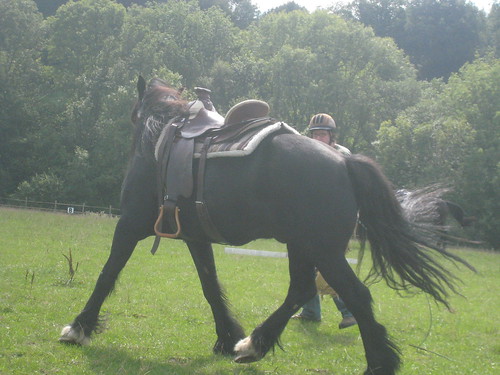Without wanting to get all Mark Rashid on you ( and without claiming to be a hundredth of the horseman that he is ) I used to be a martial artist at one time. Not a particularly good one, but I did train diligently for a long time, which is an excellent substitute for talent. One thing that is ever so important to a martial artist is the distance between you and your opponent- if you get too close they can easily attack you before you see it coming. The starting point in the art I learned that you wanted to be far enough away that you could see the whole of your opponent without having to move your eyes.
I have no interest in taking such an adversarial pose with my horse- of course not- but that doesn’t mean that I want them any closer than that. This is something I have really had to work on over the years because horses tend to want to be quite close in to you. This isn’t just a consequence of excessive friendliness, although if a horse has had a few pony treats or a lot of scratchies they might want to be near you for those reasons ( and there’s nothing wrong with that as long as they will move away when you ask them to.) The more relevant reason is that once they are confident that you aren’t going to harm them then they will start to explore whether or not they can push on you. Most of the time horses figure out the world and their relation to it through two questions:
- Do I need to run away from it?
- Can I push on it?
Very often one will start a groundwork exercise perfectly positioned and end up a lot closer to the horse than one planned to, they are masters of controlling their position relative to yours- that is what millions of years of evolution as herd animals have taught them.

It is important to maintain that distance, however, because that is what gives us the bigger picture. Details are all-important in horsemanship and we need to be able to see how the horse is carrying their head, what shape their body is in, where their feet are landing and how they are carrying their tail. It is very often once we get caught up too closely in what one part of the horse is doing that we lose track of the whole picture and whatever exercise we are working on goes straight out the window. The need to work at a useful distance from the horse is one of the reasons I favour a 12′ line rather than the shorter lead rope that many people in the UK appear to favour.
There is a secondary benefit as well, one that is particularly valuable with a more unruly horse- nobody ever got bitten, kicked, struck or trodden on by a horse that was a long way away from them. If you are in any doubt about how a horse is likely to behave, then you would be wise to keep them at a safe distance until you are sure that they don’t regard you as an opponent.

